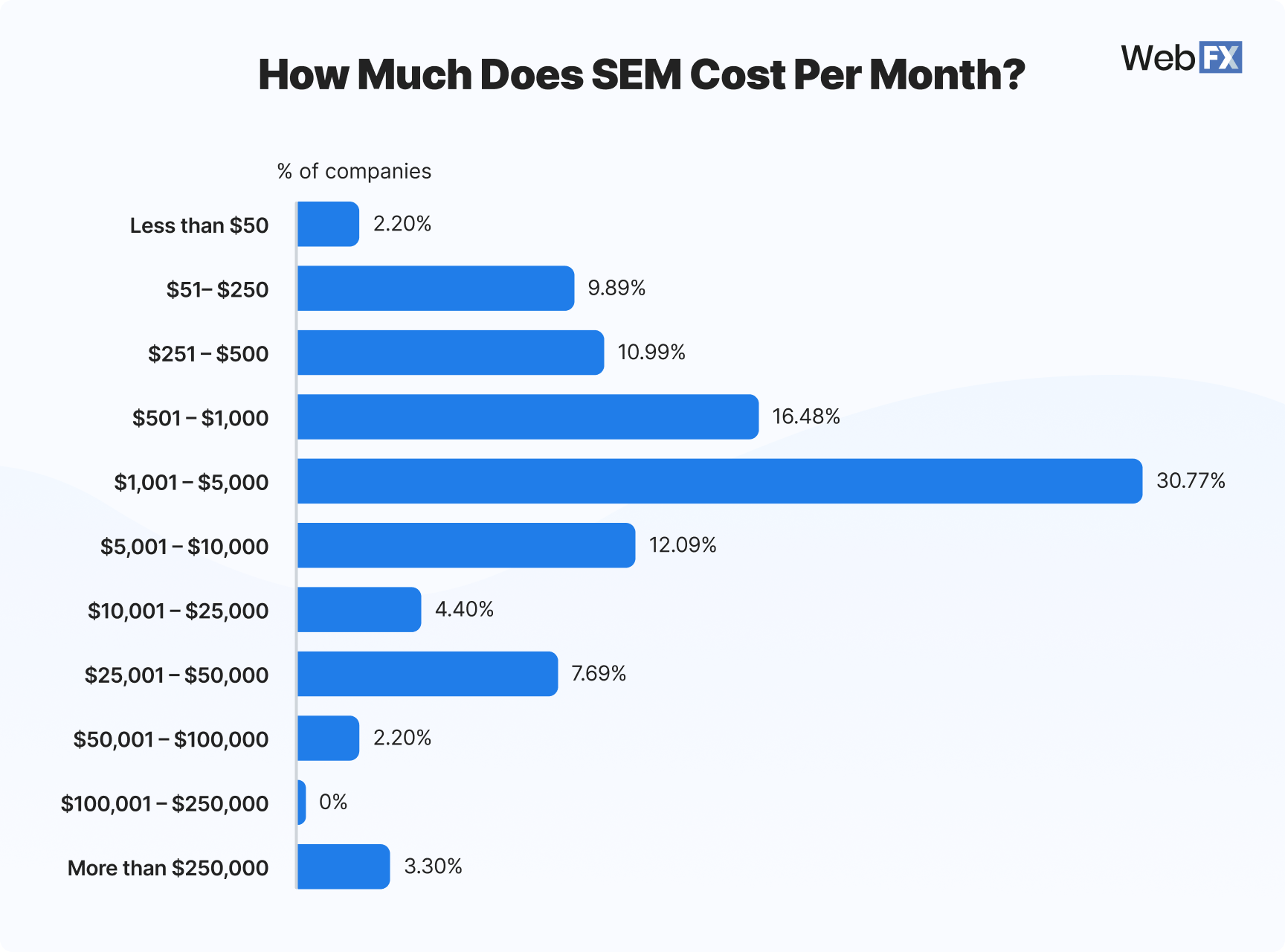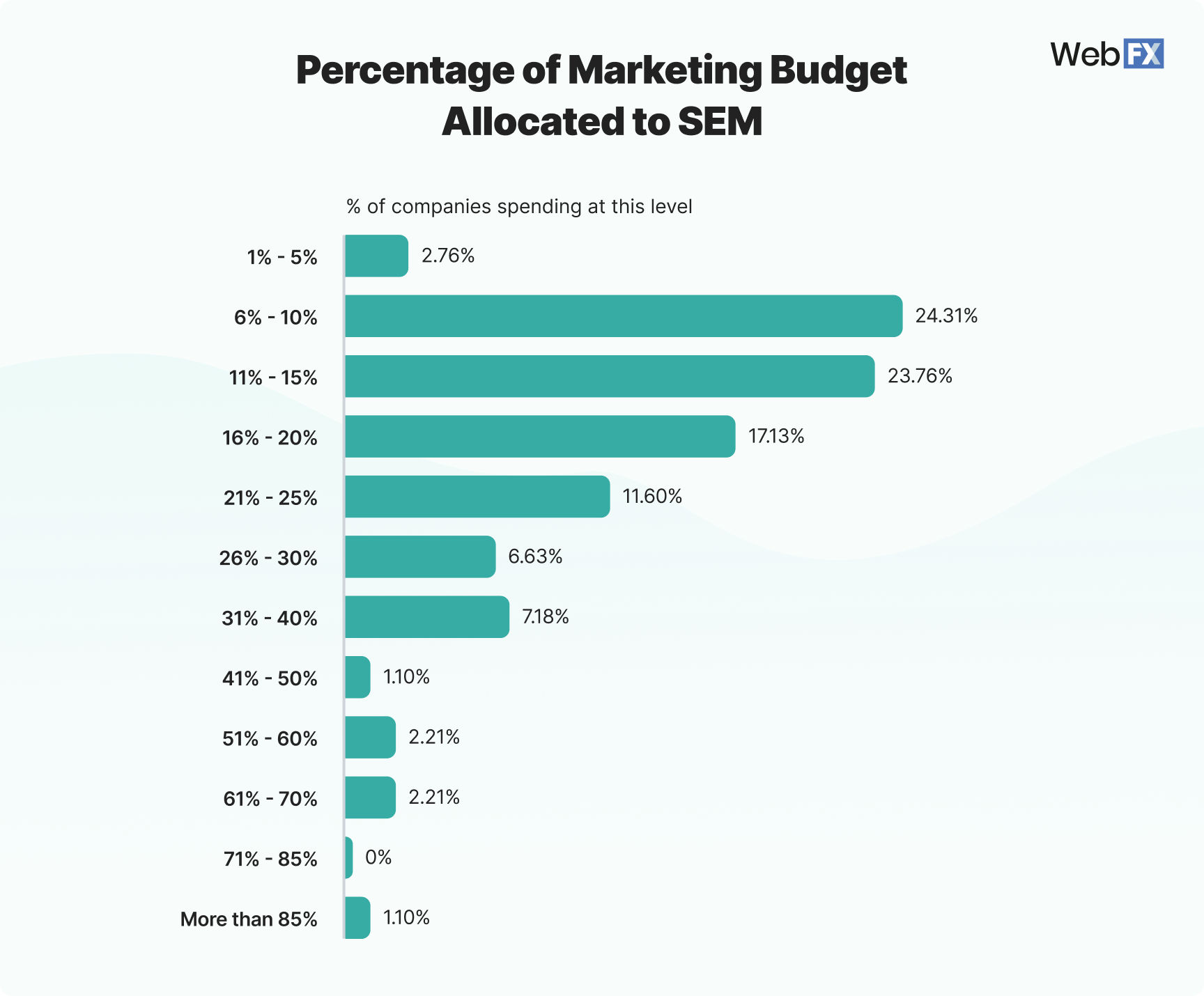How Much Do SEM Services Cost in 2025?
Last Updated: June 4, 2025
SEM pricing can vary widely depending on factors like the size of your business, the competitiveness of your industry, your chosen agency or freelancer, and more. According to our research, most businesses spend $251 - $10,000 per month on SEM. Keep reading to uncover more about SEM costs from the 250+ businesses we surveyed!Original Data:
WebFX helps companies like yours reach their business goals.
See Case Study“WebFX has always worked hard to make sure that we’re getting what we need out of the partnership, not just what may seem like the best result.”
An Inside Look at WebFX SEM Pricing
🔎 PPC and advertising audit Boost your visibility, generate leads, and drive conversions with WebFX’s custom SEM solutions tailored to your unique company’s needs, goals, and industry.
WebFX Expertise
Highlights
🖌️ Ad design
📝 Ad and custom content copywriting
🎨 SEO audit & website optimizations
💰 Bid management
Join the 1,450+ trusting WebFX to drive revenue through search engine marketing
Too many marketing providers take a copy-and-paste approach to SEM. That’s not our style.
How much does WebFX charge for SEM services?
If you’re thinking about investing in professional SEM services, WebFX offers cost-effective plans.
We also publish our SEM prices online, making it easy for you and your business to compare rates, plans, and agencies. If your company requires custom pricing, you can always connect with a WebFX strategist by contacting us online.
| Features | Aggressive | Market Leader | Enterprise |
|---|---|---|---|
| Monthly PPC spend with PPC networks | $0 - $12,000/month ad spend (paid to networks) | $12,001 - $50,000+/month ad spend (paid to networks) | $50,001+/monthly ad spend (paid to networks) |
| Keywords in campaign | Up to 2,000 | Up to 10,000 | Up to 10,000 |
| Google PPC Network | |||
| Bing PPC Networks | |||
| Google Text Ad Remarketing & Banner Remarketing (if banner ads are included, provided by the client, or creative banner design is paid for) | |||
| Google Display Network | |||
| Google In-Store Visit Reporting | |||
| Google customer match & audience match | |||
| Gmail Competitor Ads | |||
| RevenueCloudFX competitor intelligence | |||
| Initial campaign development & strategy | |||
| Advanced keyword research and selection | |||
| Industry analysis | |||
| Ad campaign copywriting | |||
| Ad copy performance testing | |||
| Ongoing keyword development and tweaking | ✓ | ||
| Dynamic keyword insertion into ads | |||
| Google analytics integration & goal tracking | |||
| Results analysis/reporting | |||
| Strategic bid management | |||
| PPC account settings monitoring (Ex. Geotargeting) | |||
| Campaigns will be managed through client's Google Ads account (client will retain Admin/owner access of all campaigns created) | |||
| Single account representative | |||
| Up to two personal consultations per month | |||
| Up to 100 web lead phone calls tracked per month (Included for all WebFX clients) | |||
| Up to 25 web lead phone calls transcribed per month (Included for all WebFX clients) | |||
| Monitoring clicks, conversions and click fraud activity | |||
| Setup and management of rule based bidding | |||
| International PPC campaign management (English only campaigns) | |||
| Setup of 1 Unbounce Landing Page template (optional) | |||
| Website conversion analysis reporting | |||
| Initial banner ad design for display & remarketing | Add $900 | 1 set included | 1 set included |
| Quarterly banner ad design for display & remarketing (a total of 4 banner ad sets a year) | Add $300 | Add $225 a month (since 1 set is included each year) | each year) Add $225 a month (since 1 set is included each year) |
| Website conversion analysis implementation | By Quote | By Quote | |
| Social Media PPC Advertising | By Quote | By Quote | By Quote |
| Landing page performance testing | By Quote | By Quote | |
| Monthly performance & analysis reporting | |||
| RevenueCloudFX Lead Tracking | |||
| Google Shopping Management | Included | Included | |
| International Campaigns (Non-English) - Each additional language monthly management cost: | $275 | $275 | $275 |
| Weekly Data Calls: Review campaign changes every 7 days | $400/month | $400/month | $400/month |
| Translation Services: | By Quote | By Quote | By Quote |
| One time setup | $750 + 1 Months Management Fee $1,250 minimum | $700 + 1 Months Management Fee $2,500 minimum | 1 Months Management Fee $7,500 minimum |
| Progressive monthly management cost: | $500 or 15%, whichever is higher | 12% of ad spend | 12% of ad spend |
Need more information? Call Us: 888-601-5359 | GET STARTED | GET STARTED | GET STARTED |
Budget over $50k/mo? Check out our enterprise campaign management offerings for campaigns from $50k-$2m/mo in ad spend.
Meet WebFX
A world-class digital marketing agency with thousands of reviews applauding our transparency.


Related Resources
-
Grow Your Sales with Google Shopping Management Services 8 minute read
-
 How to Choose the Best PPC Agency to Improve Your ROI 7 minute read
How to Choose the Best PPC Agency to Improve Your ROI 7 minute read -
The 13 Best Google Ads Agencies Around the World 2 minute read
-
The World’s Best PPC Companies in 2025 3 minute read
-
 What Do PPC Services Include? Deliverables & Benefits of Working with a PPC Agency 5 minute read
What Do PPC Services Include? Deliverables & Benefits of Working with a PPC Agency 5 minute read
SEM pricing FAQs
Get answers to FAQs about SEM costs now:
What is SEM?
SEM, also known as search engine marketing, describes online paid advertising strategies for promoting your business, products, or services. A few examples of these strategies include social media advertising, geofencing advertising, and PPC advertising.
What is SEO?
SEO, also known as search engine optimization, encompasses online strategies for improving your visibility in organic search results on search engines like Google and Bing. As a part of SEO, you optimize your website for on-page and off-page factors that influence your rankings in search results.
What is the difference between SEM and SEO?
SEO and SEM focus on your online visibility but utilize different channels and strategies to maximize it. While SEM uses paid tactics, like PPC, SEO focuses on organic ones, including on-page optimization and content marketing.
What do SEM services include?
If your company invests in SEM services, most plans will include the following:
- Setting up your advertising accounts, like Google Ads or Microsoft Advertising
- Researching your targeting options, from keywords to behavior
- Developing your ad creatives, from images to copy
- Creating your ad campaigns and ad groups
- Managing your bids
- Testing your ad performance
- Providing monthly reporting
- Additional services, such as on-page SEO services, off-page SEO services, and PPC services
Before you partner with an SEM agency, ask what their services include.
What do SEO services include?
If your company uses SEO services, you can expect plans to include:
- Setting up Google Analytics
- Auditing SEO strategy
- Researching keywords to target
- Analyzing competitor SEO strategies
- Optimizing on-site SEO factors
- Developing fresh content
- Conducting content outreach
- Monitoring keyword rankings
- Providing monthly reports
Again, before you sign with an agency, ask what their services include.
Why use SEM services?
Investing in SEM services provide your business with several advantages, including:
- Earning your website immediate online presence in search results
- Getting your site at the top of search results and in prime locations on websites
- Increasing your brand awareness, online revenue, and lead generation
- Optimizing your advertising budget by using cost-effective strategies
- Improving your paid advertising ROI
The fact that companies earn an average ROI of $2 for every $1 spent also makes SEM services valuable. Whether you want to attract new or existing customers, you can do it with a targeted SEM campaign and an experienced search engine marketing company.





